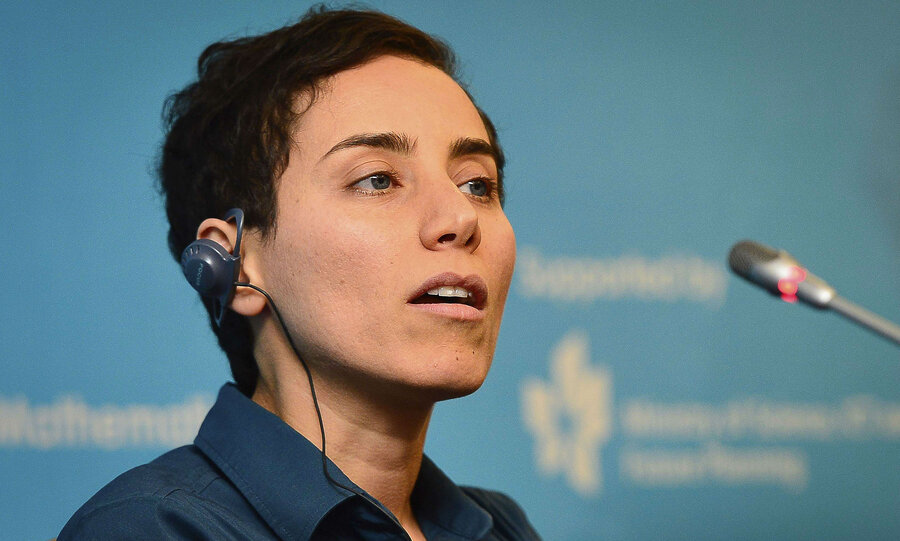Maryam Mirzakhani: Doughnuts, gender equity, and the 'Nobel Prize of math'
Loading...
Parents may want to grab a box of doughnuts for a show and tell session with kids about Maryam Mirzakhani, who just became the first woman to win “the Nobel Prize of mathematics" for her work, which includes understanding the symmetry of curved surfaces – like the surfaces of doughnuts.
It’s great to see news about a woman celebrated for her understanding of the symmetry of curved surfaces, rather than the curves of her body.
Thanks to this Iranian-born, Harvard-educated, female Stanford University professor’s achievement, another glass ceiling has fallen to pieces.
The Fields Medal is officially titled the International Medal for Outstanding Discoveries in Mathematics and was presented by the International Mathematical Union today at the International Congress of Mathematicians, held this year in Seoul, South Korea.
For the first time since the awards began in 1936, the International Mathematical Union selected a woman, and thus gave parents a fresh “in” to talk about women finding their place in STEM (science, technology, engineering, and math) fields.
While it’s easy to jump to the conclusion that until now the math union has overlooked women, the truth is that the numbers are stacked against women in STEM. Just 9 percent of tenure-track positions in math are held by women, according to The Washington Post which quoted a 2010 study.
With those odds parents need to jump at the opportunity to celebrate women in STEM – no matter how small they may be.
For example, last week parents could draw on the tiny toy version of women in STEM with the introduction of a new LEGO female scientist line of play sets finally hitting store shelves and immediately selling out.
Fortunately, today we get to talk about the life-size version of gender equality.
Professor Mirzakhani was recognized for her work on “geometry and dynamical systems, particularly in understanding the symmetry of curved surfaces, such as spheres, the surfaces of doughnuts and of hyperbolic objects,” according to a Stanford press release.
She possesses a remarkable fluency in a diverse range of mathematical techniques and disparate mathematical cultures – including algebra, calculus, complex analysis and hyperbolic geometry. By borrowing principles from several fields, she has brought a new level of understanding to an area of mathematics called low dimensional topology.
"What's so special about Maryam, the thing that really separates her, is the originality in how she puts together these disparate pieces," said Steven Kerckhoff, a mathematics professor at Stanford and one of Mirzakhani's collaborators. "That was the case starting with her thesis work, which generated several papers in all the top journals. The novelty of her approach made it a real tour de force."
Yes, this is a chance to talk math and gender equality with the kids while hitting Dunkin' Donuts for tasty examples.
When a mother of a 3-year-old shatters the glass ceiling in a STEM field, parents have another chance to reinforce, with both male and female children, the value of gender equality and the fact that girls do have a future in STEM areas.
As the mom of four sons this is the kind of news I wait for in order to educate my boys about the relationship of girls to mathematical curves and the need for gender symmetry in the professional world.
My friend, chess Grandmaster Susan Polgar, once told me the majority of female chess players drop out of the game in middle school because of peer pressure of the stigma that boys prefer girls with curves and not those who calculate the properties of curves. Susan recently gave a TED Talk on “Crushing the Glass Ceiling.”
It seems that no matter how many times I point out gender equality issues, my sons are still getting so much more pushback from social media, commercials, and the absence of women in high-profile STEM roles.
If we want to have our girls grow beyond the fantasy of a LEGO play set in STEM fields, it’s important to spend as much time drawing our kids’ attention to those who win an international math prize as we do on the Olympics, the World Cup, or the Super Bowl.
“This is a great honor. I will be happy if it encourages young female scientists and mathematicians,” Mirzakhani said in the Stanford University news release. “I am sure there will be many more women winning this kind of award in coming years.”
Until that reality comes to pass, perhaps parents can tell the bedtime story of the little girl from the war-torn country of Iran and how she helped reshape the way we think of women in math.








